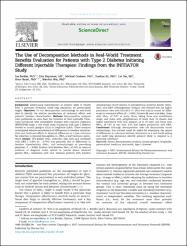Please use this identifier to cite or link to this item:
https://hdl.handle.net/20.500.11779/700| Title: | The Use of Decomposition Methods in Real-World Treatment Benefits Evaluation for Patients With Type 2 Diabetes Initiating Different Injectable Therapies: Findings From the Initiator Study |
| Authors: | Ke, Xuehua Buysman, Erin Wei, Wenhui Xie, Lin Grabner, Michael Brekke, Lee Başer, Onur |
| Keywords: | Real-world Type 2 diabetes Personalized medicine Liraglutide Insulin glargine Choice Decomposition analysis |
| Source: | Brekke, L., Buysman, E., Grabner, M., Ke, X., Xie, L., Baser, O., & Wei, W. (January 01, 2017). The Use of Decomposition Methods in Real-World Treatment Benefits Evaluation for Patients with Type 2 Diabetes Initiating Different Injectable Therapies: Findings from the INITIATOR Study. Value in Health : the Journal of the International Society for Pharmacoeconomics and Outcomes Research, 20, 10, 1252-1259. |
| Abstract: | Background: Determining characteristics of patients likely to benefit from a particular treatment could help physicians set personalized targets. OBJECTIVES: To use decomposition methodology on real-world data to identify the relative contributions of treatment effects and patients' baseline characteristics. METHODS: Decomposition analyses were performed on data from the Initiation of New Injectable Treatment Introduced after Antidiabetic Therapy with Oral-only Regimens (INITIATOR) study, a real-world study of patients with type 2 diabetes started on insulin glargine (GLA) or liraglutide (LIRA). These analyses investigated relative contributions of differences in baseline characteristics and treatment effects to observed differences in 1-year outcomes for reduction in glycated hemoglobin A1c (HbA1c) and treatment persistence. RESULTS: The greater HbA1c reduction seen with GLA compared with LIRA (-1.39% vs. -0.74%) was primarily due to differences in baseline characteristics (HbA1c and endocrinologist as prescribing physician; P < 0.050). Patients with baseline HbA1c of 9.0% or more or evidence of diagnosis codes related to mental illness achieved greater HbA1c reductions with GLA, whereas patients with baseline polypharmacy (6-10 classes) or hypogylcemia achieved greater reductions with LIRA. Decomposition analyses also showed that the higher persistence seen with GLA (65% vs. 49%) was mainly caused by differences in treatment effects (P < 0.001). Patients 65 years and older, those with HbA1c of 9.0% or more, those taking three oral antidiabetes drugs, and those with polypharmacy of more than 10 classes had higher persistence with GLA; patients 18 to 39 years and those with HbA1c of 7.0% to less than 8.0% had higher persistence with LIRA. CONCLUSIONS: Although decomposition does not demonstrate causal relationships, this method could be useful for examining the source of differences in outcomes between treatments in a real-world setting and could help physicians identify patients likely to respond to a particular treatment. Copyright (C) 2017 International Society for Pharmacoeconomics and Outcomes Research (ISPOR). Published by Elsevier Inc. All rights reserved. |
| Description: | Onur Başer (MEF Author) |
| URI: | http://dx.doi.org/10.1016/j.jval.2017.05.019 https://hdl.handle.net/20.500.11779/700 |
| ISSN: | 1098-3015 1524-4733 |
| Appears in Collections: | Ekonomi Bölümü Koleksiyonu PubMed İndeksli Yayınlar Koleksiyonu / PubMed Indexed Publications Collection Scopus İndeksli Yayınlar Koleksiyonu / Scopus Indexed Publications Collection WoS İndeksli Yayınlar Koleksiyonu / WoS Indexed Publications Collection |
Files in This Item:
| File | Description | Size | Format | |
|---|---|---|---|---|
| WOS000419245600004_Acik.pdf | Yayıncı Sürümü - Makale | 649.14 kB | Adobe PDF |  View/Open |
CORE Recommender
Sorry the service is unavailable at the moment. Please try again later.
Items in GCRIS Repository are protected by copyright, with all rights reserved, unless otherwise indicated.